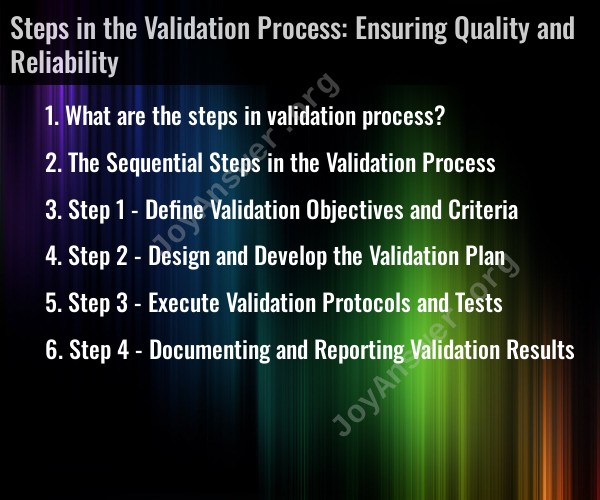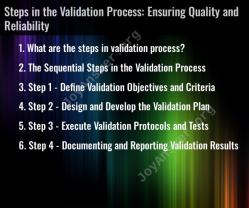What are the steps in validation process?
The validation process is a critical part of ensuring the quality and reliability of systems, products, or processes. It involves a series of systematic activities and tests to confirm that something meets its intended purpose or specifications. While the specific steps can vary depending on what is being validated (e.g., software, equipment, manufacturing processes), the general framework for validation often includes the following steps:
Define the Validation Objectives:
- Clearly outline the purpose and scope of the validation. What are you trying to validate? What are the specific requirements, specifications, and quality standards that must be met?
Plan Validation Activities:
- Develop a comprehensive validation plan that outlines the entire process. This plan should include details on the resources, timeline, personnel, and testing procedures required for validation.
Document Validation Protocols:
- Create detailed protocols and procedures that will be followed during the validation process. These protocols should specify how tests will be conducted, what data will be collected, and what acceptance criteria must be met.
Installation Qualification (IQ):
- Ensure that the equipment, systems, or software are correctly installed and set up as per the manufacturer's specifications. This step verifies that everything is in place and functioning properly.
Operational Qualification (OQ):
- Test the system or equipment to ensure it operates within specified parameters and can perform its intended functions. This includes testing the equipment under various operating conditions.
Performance Qualification (PQ):
- Conduct tests to confirm that the system or equipment consistently performs in a manner that meets the predetermined criteria and is suitable for its intended use. This often involves testing over an extended period to ensure reliability.
Documentation and Data Collection:
- Throughout the validation process, maintain thorough documentation of all tests, results, and observations. This documentation is crucial for compliance and future reference.
Data Analysis and Evaluation:
- Analyze the collected data to determine whether the equipment or system meets the predefined criteria and specifications. This step often involves statistical analysis and comparison with acceptance criteria.
Reporting and Documentation:
- Prepare a final validation report summarizing the results, findings, and conclusions of the validation process. This report serves as a formal record of the validation activities.
Review and Approval:
- The validation report should be reviewed by relevant stakeholders, including quality assurance teams, regulatory authorities (if applicable), and management. Their approval is typically required before proceeding to the next steps.
Implement Corrective Actions:
- If any discrepancies or issues are identified during the validation process, corrective actions may be necessary to address and resolve these issues.
Revalidation (if necessary):
- In cases where changes are made to the system, equipment, or process, or when a certain amount of time has passed since the initial validation, revalidation may be required to ensure continued compliance and reliability.
Maintenance and Monitoring:
- After validation is complete, regular maintenance and monitoring are necessary to ensure ongoing compliance and reliability. Changes or upgrades to the system may also trigger the need for revalidation.
Documentation Maintenance:
- Maintain thorough and organized records of the validation process and any subsequent activities. This documentation is vital for audits, compliance, and ongoing quality assurance.
The specific steps and terminology can vary in different industries and contexts, but the overall goal of validation is to ensure that systems, products, or processes consistently meet the required quality and reliability standards. Validation is particularly important in regulated industries such as pharmaceuticals, healthcare, and manufacturing, where product safety and efficacy are critical.
The Sequential Steps in the Validation Process
Validation is the process of ensuring that a system, product, or process meets its intended requirements. It is an essential step in the development of any new system or product, and it is also important for ensuring the quality of existing systems and products.
The validation process typically consists of the following sequential steps:
Define validation objectives and criteria: The first step in the validation process is to define the objectives and criteria for validation. This includes identifying the specific requirements that must be met in order for the system, product, or process to be considered valid.
Design and develop the validation plan: Once the validation objectives and criteria have been defined, a validation plan must be developed. This plan should outline the specific tests and protocols that will be used to validate the system, product, or process.
Execute validation protocols and tests: The next step is to execute the validation protocols and tests. This may involve performing functional tests, performance tests, security tests, and other types of tests.
Documenting and reporting validation results: The final step in the validation process is to document and report the validation results. This should include a detailed report of the tests that were performed, the results of the tests, and any recommendations for improvement.
Step 1 - Define Validation Objectives and Criteria
The first step in the validation process is to define the objectives and criteria for validation. This involves identifying the specific requirements that must be met in order for the system, product, or process to be considered valid.
The validation objectives should be specific, measurable, achievable, relevant, and time-bound (SMART). The validation criteria should be objective and measurable.
Here are some examples of validation objectives and criteria:
Validation objective: The system must be able to process 100 transactions per second.
Validation criteria: The system must be able to process 100 transactions per second without any errors.
Validation objective: The product must be safe for use.
Validation criteria: The product must pass all safety tests as defined by the relevant standards.
Step 2 - Design and Develop the Validation Plan
Once the validation objectives and criteria have been defined, a validation plan must be developed. This plan should outline the specific tests and protocols that will be used to validate the system, product, or process.
The validation plan should include the following information:
- The specific tests and protocols that will be performed
- The test data that will be used
- The expected results of the tests
- The acceptance criteria for the tests
- The resources required to perform the tests
- The schedule for performing the tests
Step 3 - Execute Validation Protocols and Tests
The next step is to execute the validation protocols and tests. This may involve performing functional tests, performance tests, security tests, and other types of tests.
The validation tests should be performed under realistic conditions. This may involve testing the system, product, or process in a production environment or with real users.
Step 4 - Documenting and Reporting Validation Results
The final step in the validation process is to document and report the validation results. This should include a detailed report of the tests that were performed, the results of the tests, and any recommendations for improvement.
The validation report should be clear, concise, and easy to understand. It should be written for a technical audience, but it should also be understandable to non-technical stakeholders.
The validation report should be reviewed by all relevant stakeholders, including managers, engineers, and quality assurance personnel.
Conclusion
The validation process is an essential step in the development of any new system or product, and it is also important for ensuring the quality of existing systems and products. By following the sequential steps outlined above, organizations can ensure that their systems, products, and processes meet their intended requirements.


